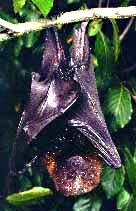 Conservation of Rodrigues Fruit Bats Conservation of Rodrigues Fruit Bats
by Blair Csuti
Bats are one of 26 orders of mammals; however they include one-fifth of all mammal species. Bats are divided into two suborders, Megachiroptera, or old world fruit bats, which contains 173 species, and Microchiroptera containing the remaining 813 species. All bats found in Oregon are Microchiroptera and their diet consists primarily of moths and beetles. The largest members of the suborder Megachiroptera are often called flying foxes (genus Pteropus), and may have wingspans up to 1.7 m (nearly 6 feet). Their diet of fruit, flowers, and nectar restricts them to the tropics, where food is available throughout the year.
The Oregon Zoo is one of eight in North America housing Rodrigues fruit bat (Pteropus rodricensis), once the rarest bat in the world. Rodrigues fruit bats are found only on the island of Rodrigues, Mauritius, about 1,000 mi east of Madagascar in the Indian Ocean. Rodrigues was uninhabited when discovered by the Portuguese in 1645. It once had a remarkable flora and fauna, including many endemic animals, including a very large land tortoise and a flightless bird known as the solitaire.
In 1691, Rodrigues was colonized by a small number of French Huguenots, whose leader, Fran˙ois Leguat, wrote an extraordinary account of the solitaire. Monogamous pairs defended a territory about 400 yards across. Fledged chicks are said to have been paired by a group of adults and escorted to a vacant territory, in what Leguat called the marriage of the solitaire. When first visited by Europeans island was completely forested.
Today, 98 percent of Rodrigues' forests have been cleared, leaving about 2,000 ha of habitat in a valley called Cascade Pigeon. Not only do forests supply Rodrigues fruit bat with food, they provide shelter from cyclones that frequently sweep the island. A series of violent storms in the 1970s reduced the population of Rodrigues fruit bats to about 70. In response, 23 bats were removed for captive breeding by the Jersey Wildlife Preservation Trust. Our colony descends from these founders.
Currently there are 300 Rodrigues fruit bats in North American zoos and about 1,000 in the wild. Despite this remarkable recovery, continued threats to Rodrigues' remaining forests called for increased conservation efforts.
In 1995, Philadelphia Zoo's One With Nature Program began planning for a full-time environmental educator on Rodrigues who would work to increase local awareness of the island's unique biological heritage and of ways to improve conditions for both the native biota and the island's 35,000 inhabitants.
This year, in cooperation with the Maurtian Wildlife Foundation, Ms. Mary Jane Raboude was hired to launch the new environmental education program. Mary Jane is a native of Rodrigues who received her bachelor's degree from the Catholic University of Sydney. Mary Jane reported on her work during a panel session organized by Roger Yerke, one of our Education Managers, at last month's AZA conference.
In response to a call for support from Kim Whitman, Species Survival Plan coordinator, The Oregon Zoo Foundation is providing part of Mary Jane's salary this year. We are pleased to be involved in a program contributing to the survival of Rodrigues fruit bat and the island's other native plants and animals.
back to top
|


